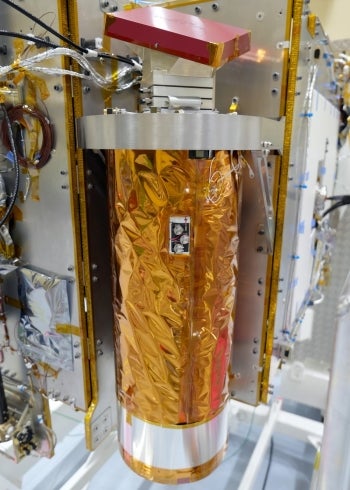Tightening the 'collar' around the moon’s darkest mysteries

NASA's Shadowcam instrument. Photo courtesy KARI (Korea Aerospace Research Institute)
Unlike the Earth, the moon tilts only slightly on its axis — about one-and-a-half degrees, compared with the Earth’s 23-degree tilt.
Because of this, there are certain places on the moon that never see the light of the sun. Lunar scientists call these the moon’s permanently shadowed regions, or PSRs.
Now, scientists at Arizona State University have begun probing inside those regions with the help of the NASA ShadowCam instrument. The latest bundle of images, taken by ShadowCam between April and June of last year, reveal the moon’s shadowed areas in far greater detail than Earth-based telescopes or earlier orbiting spacecraft have ever done before.
Video by Steve Filmer
The secret behind ShadowCam’s success
Many of the moon’s darkest places are at its poles, where it’s thought there may be water ice and other useful substances that could support astronauts, landers and rovers.
In order to make those places more visible, ShadowCam amplifies the small amounts of light reflected off the edges of crater rims as it orbits the moon aboard the Korea Pathfinder Lunar Orbiter. With the dark areas illuminated, ShadowCam takes a series of images, drawing ever tighter circles — called “collars” — with each orbital pass. When stitched together, the images create a visual map of the area.
Nick Estes, the science operations manager for ShadowCam, says the “collars” approach means the research team can exceed the original mission goals because they are able to image PSRs of all sizes within the collar areas, rather than focusing only on the larger ones.
“Humans are very visual,” Estes says. “We like to see the surface, see what these features look like, to be able to make interpretations of what's there. That's what ShadowCam's going to let us do.”
Shadows within shadows
Like most of the rest of the moon’s surface, many of the PSRs are dotted with impact craters, within which there are sometimes more craters. That makes getting an image especially challenging. But it also adds to the excitement of looking at places on the moon that have never been seen before.
“We haven't seen any obvious signs of large chunks of ice or anything like that, but it doesn't mean it's not there,” Estes says.
Explore the latest ShadowCam images at data.ser.asu.edu.
More Science and technology

ASU professor honored with prestigious award for being a cybersecurity trailblazer
At first, he thought it was a drill.On Sept. 11, 2001, Gail-Joon Ahn sat in a conference room in Fort Meade, Maryland. The cybersecurity researcher was part of a group that had been invited…

Training stellar students to secure semiconductors
In the wetlands of King’s Bay, Georgia, the sail of a nuclear-powered Trident II Submarine laden with sophisticated computer equipment juts out of the marshy waters. In a medical center, a cardiac…

ASU startup Crystal Sonic wins Natcast pitch competition
Crystal Sonic, an Arizona State University startup, won first place and $25,000 at the 2024 Natcast Startup Pitch Competition at the National Semiconductor Technology Center Symposium, or NSTC…
